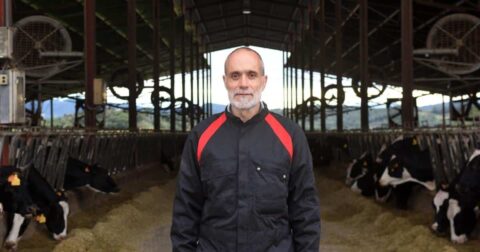Explainer
Your Thanksgiving Meal’s Climate Impact, in 4 Charts
Climate•4 min read
Perspective
Animal agriculture is one of the leading sources of methane emissions, but world leaders have a bad habit of downplaying its impact or ignoring it entirely.


Words by Judy Bankman, Brighter Green
On November 2nd, over 100 world leaders at COP26 in Glasgow signed the Global Methane Pledge: an initiative to reduce global methane emissions 30 percent by 2030. While this pledge has largely been viewed as an important first step to addressing climate change through methane, gaps remain. Namely, agriculture is an afterthought rather than a centerpiece, despite the fact that 40 percent of methane emissions stem from the agriculture sector, with 32 percent coming directly from livestock production.
Without examining agriculture and developing concrete strategies to reduce methane emissions within this sector, we will miss a critical opportunity to prevent further catastrophic impacts of climate change.
Enteric fermentation, a digestive process in ruminant animals like cows, is the primary source of agricultural methane emissions. We have seen a 17.5 percent increase in agricultural methane emissions since 1990; in contrast, carbon dioxide and nitrous oxide each increased about 10 percent. Methane has a very short lifetime: about a decade, as compared to carbon dioxide, which can live in the atmosphere for up to 300-1000 years. Yet, methane is 25-35 times more powerful at warming the atmosphere.
This means that cutting methane emissions will yield results more quickly as opposed to solely focusing on carbon reduction. Yes, one’s “carbon footprint” is still important, but so is methane. As Civil Eats Reporter Lisa Held aptly puts it, “if we compared responses to the climate crisis to responses to a hunger crisis, cutting methane would be emergency food aid and cutting carbon dioxide would be raising wages and ending systemic racism.”
In May 2021, the United Nations Environment Program (UNEP) released the Global Methane Assessment (GMA). This report provides an analysis of global methane sources as well as targeted measures for each major methane-emitting sector to reduce its emissions. Agriculture figures prominently in the GMA and the report dedicates a section to how shifts toward plant-based diets can help reduce methane in the atmosphere.
Despite UNEP’s findings, the Global Methane Pledge does not focus on agriculture, nor dietary shifts. The Pledge signatories commit to seeking “abatement of agricultural emissions through technology innovation as well as incentives and partnerships with farmers,” though it’s unclear what these partnerships would look like. Behavioral shifts like dietary change and reducing food waste are not included in the Pledge.
This begs the critical question, why is agriculture, and specifically livestock production, routinely left out of dialogues about climate change and methane abatement?
Throughout the last several years, the world has witnessed unprecedented fires in the Amazon, the Brazilian Pantanal, and western North America. We have seen severe hurricane seasons, ocean acidification caused by warming waters, and the loss of entire ecosystems. Both wild and domesticated animals suffer the consequences of extreme weather. Climate change does not impact all communities equally, either, with those in the Global South and those with lower incomes shouldering the biggest burden. These realities have captured the attention of the public as well as some policymakers. And yet, the conversation on climate change consistently excludes agriculture, and when it doesn’t, it focuses on quick fixes like feed additives and biogas digesters rather than long-term solutions.
So what are long-term solutions, and what kind of commitments should world leaders at COP26 focus on?
First, we need acknowledgment from the United States, the European Union, and other world leaders that our current system of export-driven industrial agriculture, specifically livestock production, is unsustainable and a major cause of GHGs, including methane. Second, emissions from industrial operations should be strictly regulated and enforced, and moratoria put on new CAFOs and other large-scale operations. Third, governments should move funding from existing commodity subsidies to agroecological systems of production which value biodiversity, entire ecosystems, and individual animals. And finally, since 2010, the UN has acknowledged that consuming less meat and dairy would help counter the effects of climate change. Now it’s time for the UN and governments around the world to work together to encourage this shift.
The Global Methane Pledge is a step in the right direction. But concrete steps to limit the scale of mass livestock production, move subsidies away from industrial agriculture, and encourage plant-based dietary shifts are needed in order to effectively combat climate change in a continually warming world.